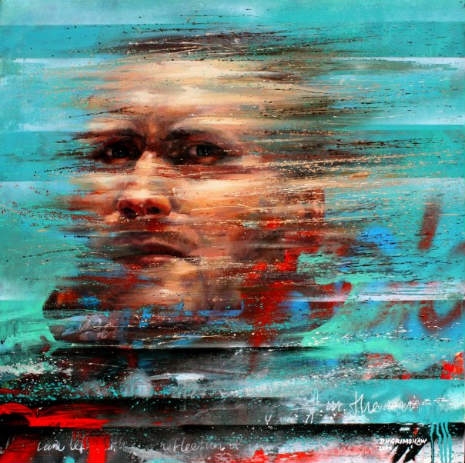
There wasn’t anyone artistic in Dale Grimshaw’s family, it was just something to do, and learn along the way. That he had a natural talent was obvious, but he developed it through a difficult and potentially violent childhood – the experience of which informs many of his paintings.
Indeed, it was this kind of emotional power in one of his paintings (a self-portrait) that brought me to his brilliant, visceral and original work. His portrait may have seemed imperious, but his eyes revealed a vulnerability, a tremendous humanity and soul.
Originally a street artist, Dale Grimshaw is now one of Britain’s most exciting and talented young artists, and last year, his one-man show Moreish was a hit with both public and critics. I contacted Dale to ask him more about his life, his work and how he started out.
Paul Gallagher: What was the first turning point in your career as an artist?
Dale Grimshaw: Probably getting in at Middlesex University, formerly Hornsey College of Art. It meant I had to really consider the moves I was making in life. I had no support from anywhere else; just my rented flat, my belongings and myself. It meant I’d have to sell it all and move from Lancashire. It was a springboard to other things and places.
Paul Gallagher: Tell me about your childhood and first artistic ambitions?
Dale Grimshaw: There wasn’t anyone artistic, in the literal sense, in my family. I just naturally continued drawing and painting long after other kids had normally given up all that creative nonsense outside of school.
At secondary school, there wasn’t anyone that took any notice of my abilities. Little did my art teacher know that I was practicing to paint with oil paints I’d nicked from shops at home. Ironically, she was called Mrs. Oil but she would rather hit you than take any real interest. My mom saw I had talent and did her best to encourage me.
I first saw ‘The Stranglers’ written in huge letters on a bus stop wall in the late 70s. I was hooked and fascinated by the idea and mystery of graffiti. I wrote on walls, playgrounds, bus seats, textbook covers, and my own body even. Sadly at the age of 15 I tattooed my own arm with my ‘tag,’ which is still there today, as bold as ever. I hated it for decades… bad karma, anyone?’
Grimshaw had a difficult childhood. His father was violent and abusive, as Dale told Ragazine:
My experiences as a child in a very difficult and potentially violent environment, has had a strong impact on all parts of my life. My father was a violent and cruel man, whose presence in the family home caused physical and emotional pain for us all. My mum was the focus of his violent behavior and she really suffered at his hands. We were left homeless after fleeing the family home. We lived in so many places after that, including a caravan in a farmer’s field and also a gutted farm house that was home to chickens – the chickens still came in to visit after that! My oldest sister witnessed a lot more than me and sadly I believe it really brought the worst out in her in later years.
Being a child in that type of situation is a nightmare. All the things that should be there to support you and help you develop as an adult are undermined by the fear and unpredictability of the situation. My mother did her best to protect us, but she was lonely and vulnerable herself. Despite all that happened in the early days, my Mum’s love has shone through for me and I have held onto that as an adult, despite losing her tragically early when I was only nineteen. Without this love, I can’t imagine how I could have carried on and achieved anything as an adult.
Paul Gallagher: What elements of your childhood have influenced you?
Dale Grimshaw: All of it has had some influenced on me. However, I do tend to focus more on the sad or negative experiences and memories of much earlier times. - This isn’t to say that it was all bad, not at all. I was very unhappy as a teenager, not really knowing where the boundaries where, struggling with my sexuality, along with drinking and substance abuse. I did the show Semi –Detached that touched on family/personal life struggles. It’s amazing how many people have had fucked up childhoods or have just generally struggled with life or who they are. If I manage to capture these experiences and feelings on canvas with the right tone, then they can really resonate with people.

Paul Gallagher: Tell me about your early works - what were your intentions?
Dale Grimshaw: My first real, established theme was probably where I explored the meat industry and mass manufacturing. It was all a pretty obvious approach - dripping carcasses made up of collaged photocopies of £10 notes, covered in red splashes. Despite a tutor saying something to the effect of “Grimshaw, you’re as subtle as a brick shithouse,” I can see with hindsight what I was trying to achieve in terms of the technique and the application of the paint. I was laying the foundation for what was to come.
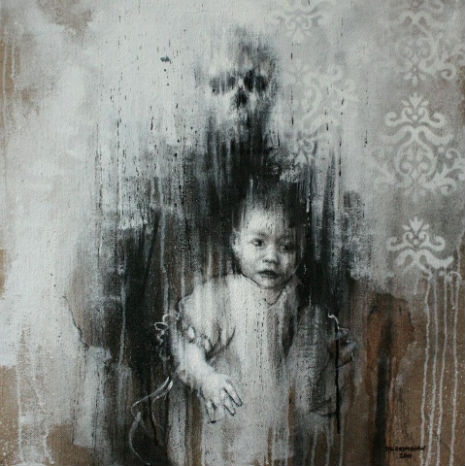
Paul Gallagher: Who and what have been your influences?
Dale Grimshaw: I was very much interested in what was known as the “Glasgow Boys” - Peter Howson, Ken Currie and the like, this was before I studied painting at college.
A print of a Constable painting in our council house, as a child, set me off on a painterly journey. Lucian Freud contributed to this journey that I’m still on. Then other imagery like record covers and illustrations in history books grabbed my attention and guided me another way too. Now, I thankfully have a greater appreciation for Rubens, Rembrandt and all the other big guns.
Paul Gallagher: How did you develop your original and distinctive style?
Dale Grimshaw: Most people presume I had gone through that almost obligatory Francis Bacon obsession at Art College, but I hadn’t. In fact, it was only about 7 years ago that I really became enraptured by Bacon’s work. I first experimented with the more blurred aspect of my style in the very early 90’s. I used to get frustrated with painting more academic portraits and such and so I began to try and capture energy, movement or an aura when painting figures – similar to a blurred video still.
Now I’m also known for a more splattered style. Again, I found that having bold, definite lines around my figures gave them a dead, stationary feel, so I discovered this way of using fine splatters to describe certain parts of the anatomy. I also love the collage look and use that along with spray paints.
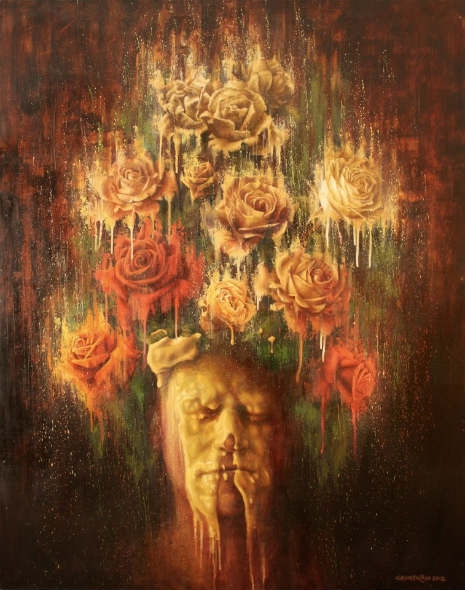
Paul Gallagher: Take me through the process of making a painting?
Dale Grimshaw: At some point I’ll lie awake at night, usually on the edge of the bed, due to a cat hogging my space. I‘ll sometimes have a loose idea that’s been floating round in my head for some time - so this silent, nocturnal time is a good opportunity to imagine how the composition could work. The next stage will involve me initially finding images off the Internet, or I’ll go straight into taking my own photographs. I’ll then create several digital sketches. When I’m satisfied, I’ll start blocking the painting in with very thin acrylics or I’ll paint on separate collage elements, which will be glued to the rigid painting support later on.
Sometimes the paintings stay as acrylic based paintings or, I continue them with oils. Most paintings come together, although some can be very problematic and can end up being drastically different in composition. I feel I learn more from these latter works.
Paul Gallagher: Tell me about some of the different projects you have been involved with?
Dale Grimshaw: In the last few years, I’ve got my teeth back into leaving my mark outdoors, primarily with large woodcut prints. Initially a lot of people didn’t make the connection but now people seem to recognize my outdoor style. Besides, there isn’t really any of the London lot working with woodcut prints outside. My prints have ended up being pasted in cities across the world from Brazil, China, Holland & Germany. In 2013, I want to focus more on this technique but also on painting larger scale outside too. Along with group shows, over the last few years I’ve done various live painting jams/festivals – they are a good way of getting across to new people, chatting and demonstrating my technique.
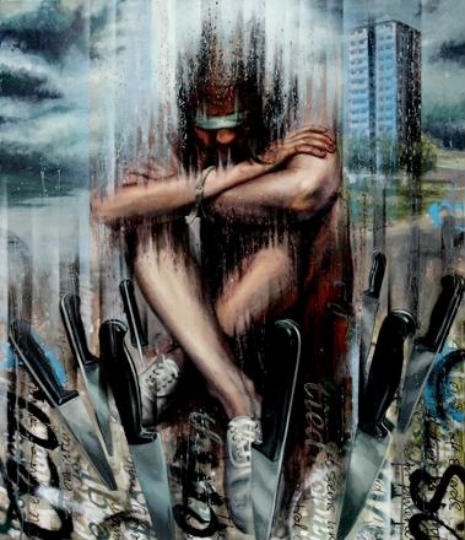
Paul Gallagher: Tell me about some of your own favorite paintings?
Dale Grimshaw: 8 of Swords was from the Arcana (Tarot) show in 2010 – I felt I had really made a break-though with this painting - I captured a very confident and fleshy feel with the androgynous figure, balanced out by a moody, bluish background with a wash of calligraphy bleeding over parts – Adam Ant wanted this one but it had been sold already.
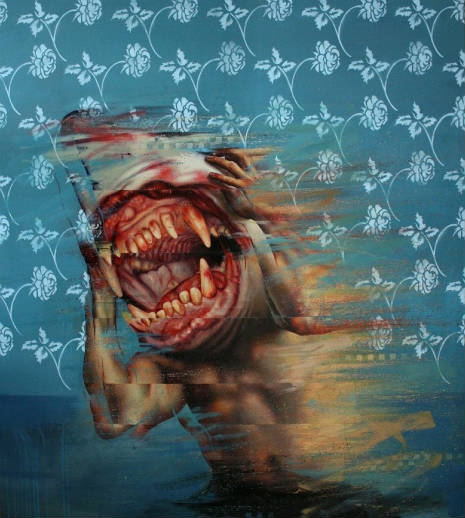
Dale Grimshaw: The Hunger - People either loved or hated this large piece, with its gaping sharks head and dogs teeth, set against some nice floral wallpaper - it had a very visceral feel. I think it really illustrated a raw and frustrated fury.
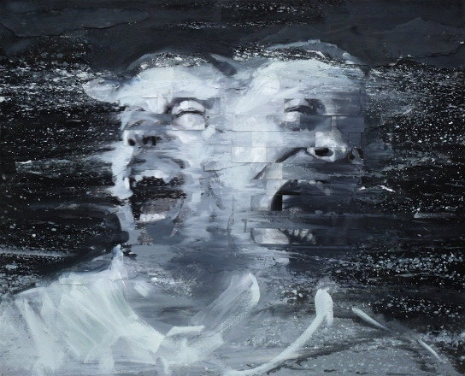
Dale Grimshaw: Exorcism – this monochrome piece from early 2008 now seems slightly crude, in terms of the technique, although that doesn’t detract from the fact that this is a very emotionally charged painting full of anger, frustration and energy. I did a bigger, full-bodied, color version of this called Purgatory, which I love.
Paul Gallagher: Tell me about your first important exhibition?
Dale Grimshaw: I first showed my work at the Lewis Textile museum in Blackburn, Lancashire. It was a an annual group show targeted at the more senior watercolor, still life artists – so there was me with big oil paintings of punk gigs and riot scenes. They seemed to like it though. Never underestimate an OAP!
My first show at Signal Gallery was a big turning point as it showed me what I could achieve – it was very well received and I sold a lot of work, which gave me confidence to surge forward.
Paul Gallagher: Tell me about the themes and ideas that are in your work?
Dale Grimshaw: I always have this crazy idea that there’s this really clever and grand master plan or concept that I need to capture in my paintings, when in fact my work tends to operate the best and pack a powerful punch when it’s based on personal emotions – fear, alienation, frustration and anger to name a few. I try to capture what I call a psychological narrative in the work.
Paul Gallagher: Has your art become more political or personal?
Dale Grimshaw: With the last solo show I did Moreish, I went off on a very different trajectory. It was less obviously personal and had a subtle but definite political message underneath. I think it made the viewer work a little harder to get what the painting was saying, as opposed to previous shows were some of the works communicated quite quickly to people. I’m currently working on some pieces that explore a more personal and atmospheric approach, a very different palette too.
See more of Dale Grimshaw’s work here.
All artworks copyright to Dale Grimshaw